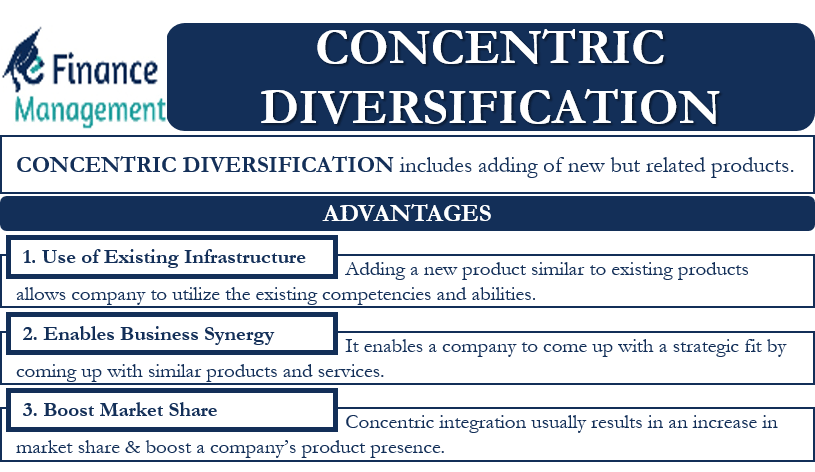Businesses use various strategies for their growth. We broadly classify them into four main categories. And these are horizontal diversification, vertical diversification, conglomerate diversification, and concentric diversification. Here we will talk about the last one. Under concentric diversification, a firm adds new but related products. In other words, to increase the revenue and grow its business, a company adds new but similar products to its existing product lines. The similarity could be in terms of distribution, technology, customer usage, and managerial skills. We also call this strategy convergent diversification.
By coming with similar products, a firm is able to benefit from its current infrastructure, experience, and technical expertise. Basically, the new product is a “strategic fit” to the company’s present line of business.
Such type of diversification can help companies if they are experiencing a drop in sales for a particular related product though the overall sector demand is the same or growing. This will also help in achieving operational synergy. If a company is witnessing declining sales, then the revenue from new products will compensate for the loss in sales for the older products.
One example of concentric diversification is a computer maker, who is experiencing a drop in PC sales. Thus, to boost revenue, the computer maker can start selling laptops and tablets. Another example is when a pizza restaurant adds pasta and calzones to its menu.

Advantages of Concentric Diversification
Concentric diversification offers many advantages to a company. These are:
Use of Existing Infrastructure
Since a firm adds a new product that is similar to its existing products, it allows the company to utilize its existing competencies and abilities. So the company does not have to start from scratch. It has the basic infrastructure to develop and sell new products.
Using the above example of the pizza restaurant, the restaurant will not need to invest much in terms of raw materials and equipment as well to start making pasta and calzones. This is because the basic ingredients of pasta and calzones are similar to pizza.
Along with infrastructure, such diversification allows businesses to use their past experience in developing, selling, and distributing new products or services.
Enables Business Synergy
The use of this diversification allows businesses to achieve synergy. This primarily means the ability of the smaller departments to contribute significantly to the bigger goals that would otherwise have been impossible. Such diversification enables a company to come up with a strategic fit by coming up with similar products and services.
For example, a pizza restaurant may acquire other restaurants in other areas offering similar products. This way, the restaurant would be able to offer its pizza in those restaurants. Also, it could offer its products in its restaurants to increase revenue. In such a situation, the restaurant in the first place will be able to attract and get new customers. Moreover, it would get more sales and revenue from its existing customers by offering pasta and pizzas.
Also Read: Diversification
Boost Market Share
The use of concentric integration usually results in an increase in market share. Market share is a primary determinant of business success. The use of this diversification strategy does boost a company’s product presence. This eventually translates into higher sales and more market share.
Final Words
Concentric diversification is a very important business strategy that can help businesses to avoid downturns. However, for this strategy to be successful, it is crucial that the quality of the new product or service matches (or exceeds) the existing ones. If the quality of the new products fails to meet customers’ expectations, then the diversification would fail. Not only will it fail, but it will also dent the reputation of the company and may affect its existing product sales too.
Frequently Asked Questions (FAQs)
Under concentric diversification, to increase the revenue and grow its business, a company adds new but similar products to its existing product lines.
1. The company does not have to start from scratch as it has the basic infrastructure to develop and sell new products.
2. Allows businesses to achieve synergy.
3. Concentric integration usually results in an increase in market share.
One example of concentric diversification is a computer maker experiencing a drop in PC sales. Thus, to boost revenue, the computer maker can start selling laptops and tablets.
RELATED POSTS
- Vertical Diversification – Meaning, Types, Examples, and More
- Ansoff Matrix – Meaning, Strategies, Steps and Examples
- Horizontal vs Vertical Integration – All You Need To Know
- Advantages and Disadvantages of Focus Strategy
- Product Extension Merger: Meaning, Advantages, Examples & More
- Advantages and Disadvantages of Multidomestic Strategy

